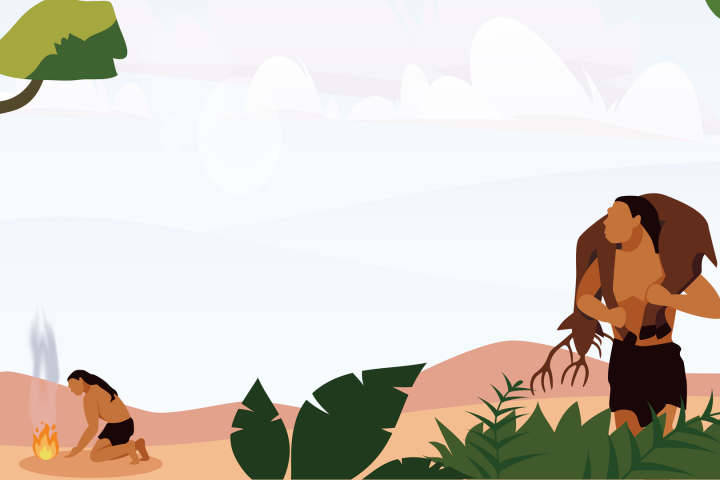從遠古近親而來的遺傳訊息
By Sirius Lee 李揚

來自尼安德河谷的人類
有著與別不同的認知模式,我們人類擁有大多數生物皆無法比擬的智慧,在科學上被名為Homo sapiens,拉丁語上解作「智人」。然而,過去曾有物種與我們有著意外地相似的外貌,他們也懂得運用自製工具,例如使用打磨過的鋒利長矛打獵 [1]。被形容為我們的「姊妹物種」或「遠親」,他們的主要遺骸於 1856 年在德國的尼安德河谷(Neander Valley)首次被發現,人類學家因此將他們命名為Homo neanderthalensis,意思是「來自尼安德河谷的人類」[2]。
古遺傳學先鋒 — Svante Pääbo
古遺傳學是透過提取和分析殘留在古代生物中的遺傳物質來研究過去的一門學科。在最近四十年,Svante Pääbo教授徹底改變了我們對人類進化歷史的理解 [3]。Pääbo 教授以馬克斯•普朗克進化人類學研究所進化遺傳學系主任的身份,率先把尖端的次世代定序法應用在進化遺傳學上,並參與解決過程中遇到的技術障礙 [4]。2002年,他的團隊發表了關於 FOXP2 基因演化的論文,引發學術界對了解其在人類發展說話能力和語言上可能扮演角色的廣泛興趣 [5, 6]。2006年,他展開了找出整個尼安德特人(Neanderthal)基因組序列的研究項目,而序列草稿最終於2010年 5月發布 [7]。2010年3月,他又發現了另一個已滅絕人類物種 — 丹尼索瓦人(Denisovan) [8]。這些貢獻都對我們有深遠的影響,改變了我們對人類進化和遠古近親的認知。
尼安德特人在我們DNA中的遺痕
隨著長達三十億個字母的尼安德特人基因組在2010年被首次測序,它揭示了尼安德特人和現代人類DNA的相似度達99.7% [6]。對基因組作出的計算和化石記錄推測,Homo sapiens與Homo neanderthalensis在 400,000至700,000年前擁有共同祖先,兩者之間有著密切的親緣關係 [9-11]。最引人注目的研究結果是,透過分析來自不同大陸五個現代人類的基因組,我們發現非非洲裔現代人類基因組中的2% 是從尼安德特人遺傳下來的,而在兩個非洲人的基因組中並沒有發現尼安德特人的 DNA [9]。儘管樣本數量有限,但結果似乎支持著名的「源出非洲」模型,即是假設非洲是人屬(Homo)的單一起源地。研究人員相信人屬在歷史上曾分幾次遷離非洲 [12],並猜測當現化人初次遷出撒哈拉以南非洲地域的時候,我們遇到了更早離開非洲的尼安德特人和丹尼索瓦人並與其雜交 [12]。雜交假說現在得到許多遺傳學分析的支持 [13, 14],包括上述只在非非洲裔基因組中發現2% 尼安德特人DNA的研究 [9]。
我們不僅找到更多證據來重整我們的系譜(genealogy),更找到與這些DNA印記相關的性狀(traits)。2020 年 9 月一篇發表在《自然》期刊的論文指出,人類第三對染色體中遺傳自尼安德特人的一個片段被確定是感染 SARS-CoV-2後呼吸衰竭的風險位點(risk locus)[15],意思是該處可能含有一個版本的基因(科學上稱為等位基因),它與嚴重感染和住院風險有關。該等位基因分別影響約 50% 和 16% 的南亞和歐洲人 [15]。科學家認為,該等位基因過往可能有助引發針對古代病原體的免疫反應,賦予個體顯著的生存優勢,因此在物競天擇的演化過程下被揀選而在一些族群中得以保留 [16]。可是,這些古老基因在今天卻可能對我們不利,因為在 COVID-19 感染中它們可以引起過份強烈,甚至是致命的免疫反應 [15]。
我們的第二個遠親 — 丹尼索瓦人
越來越多關於人類祖先的發現亦令進化樹的分枝繼續糾纏。除了古代人類尼安德特人以外,丹尼索瓦人(Denisovans)也大約在 40,000 到 400,000 年前在歐洲和西亞居住 [17]。這群已滅絕的人類物種由Pääbo教授從手指骨碎片提取的遺傳物質中被初次發現,由於該樣本取自俄羅斯阿爾泰山脈丹尼索瓦洞穴(Denisova Cave),因此這群人類被稱為「丹尼索瓦人」 [18]。在解剖學上推斷,丹尼索瓦人應該具有長形的臉、寬闊的盤骨、較長的牙弓和側向擴張的顱骨 [19]。
在基因上,也有證據顯示丹尼索瓦人、尼安德特人和現代人祖先之間曾經雜交過 [11, 20]。丹尼索瓦人的痕跡現在主要可以在東南亞和太平洋島民人口的基因組中找到,而世界其他地區的人則只含有非常低的,或是無法檢測到丹尼索瓦人 DNA序列 [17]。與從尼安德特人得來的遺傳變異相似,來自丹尼索瓦人的遺傳變異也會參與塑造我們許多特徵,例如頭髮質地、身高、嗅覺敏感度和免疫反應 [17]。
探索未知的過去
人類古代 DNA 研究的興起不僅是滿足我們單純的好奇心,也為我們提供了一些新見解,解釋進化過程如何把我們塑造成今天的人類;換句話說,是什麼令人類擁有人類的特質。關於人類在適應環境和疾病抵抗性上改變的這些驚奇發現,揭示了許多關於我們人類自身的有趣事實,亦讓我們意識到我們所知的其實只是冰山一角 — 你們未來願意追隨 Pääbo 教授的步伐嗎?
參考資料:
[1] Williams, F. L., Trinkaus, E., & Tuttle, R. H. (2020, February 6). Neanderthal. Encyclopedia Britannica. Retrieved from https://www.britannica.com/topic/Neanderthal
[2] Dorey, F. (2020, December 3). Homo neanderthalensis – The Neanderthals. Retrieved from https://australian.museum/learn/science/human-evolution/homo-neanderthalensis
[3] Zagorski, N. (2006). Profile of Svante Pääbo. Proceedings of the National Academy of Sciences of the United States of America, 103(37), 13575-13577. doi:10.1073/pnas.0606596103
[4] Stiller, M., Green, R. E., Ronan, M., Simons, J. F., Du, L., He, W., … Pääbo, S. (2006). Patterns of nucleotide misincorporations during enzymatic amplification and direct large-scale sequencing of ancient DNA. Proceedings of the National Academy of Sciences of the United States of America, 103(37), 13578–13584. doi:10.1073/pnas.0605327103
[5] Enard, W., Przeworski, M., Fisher, S. E., Lai, C. S. L., Wiebe, V., Kitano, T., … Pääbo, S. (2002). Molecular evolution of FOXP2, a gene involved in speech and language. Nature, 418(6900), 869–872. doi:10.1038/nature01025
[6] Hunter P. (2019). The riddle of speech: After FOXP2 dominated research on the origins of speech, other candidate genes have recently emerged. EMBO reports, 20(2), e47618. doi:10.15252/embr.201847618
[7] Green, R. E., Krause, J., Briggs, A. W., Maricic, T., Stenzel, U., Kircher, M., … Pääbo, S. (2010). A draft sequence of the Neandertal genome. Science, 328(5979), 710–722. doi:10.1126/science.1188021
[8] Krause, J., Fu, Q., Good, J. M., Viola, B., Shunkov, M. V., Derevianko, A. P., & Pääbo, S. (2010). The complete mitochondrial DNA genome of an unknown hominin from southern Siberia. Nature, 464(7290), 894–897. doi:10.1038/nature08976
[9] National Human Genome Research Institute. (2010). Complete Neanderthal Genome Sequenced. Retrieved from https://www.genome.gov/27539119/2010-release-complete-neanderthal-genome-sequenced
[10] Stringer, C. (2016). The origin and evolution of Homo sapiens. Philosophical transactions of the Royal Society of London. Series B, Biological sciences, 371(1698), 20150237. doi:10.1098/rstb.2015.0237
[11] Prüfer, K., Racimo, F., Patterson, N., Jay, F., Sankararaman, S., Sawyer, S., … Pääbo, S. (2014). The complete genome sequence of a Neanderthal from the Altai Mountains. Nature, 505(7481), 43–49. doi:10.1038/nature12886
[12] Sanders, M. F., & Bowman, J. L. (2019). Genetic analysis: an integrated approach (3rd ed.). New York, NY: Pearson Education.
[13] Sankararaman, S., Patterson, N., Li, H., Pääbo, S., & Reich, D. (2012). The date of interbreeding between Neandertals and modern humans. PLoS genetics, 8(10), e1002947. doi:10.1371/journal.pgen.1002947
[14] Wall, J. D., Lohmueller, K. E., & Plagnol, V. (2009). Detecting ancient admixture and estimating demographic parameters in multiple human populations. Molecular Biology and Evolution, 26(8), 1823–1827. doi:10.1093/molbev/msp096
[15] Zeberg, H., & Pääbo, S. (2020). The major genetic risk factor for severe COVID-19 is inherited from Neanderthals. Nature, 587(7835), 610–612. doi:10.1038/s41586-020-2818-3
[16] Luo, Y. (2020). Neanderthal DNA highlights complexity of COVID risk factors. Nature, 587(7835), 552–553. doi:10.1038/d41586-020-02957-3
[17] U.S. National Library of Medicine (2020). What does it mean to have Neanderthal or Denisovan DNA?. Retrieved from https://medlineplus.gov/genetics/understanding/dtcgenetictesting/neanderthaldna
[18] Warren, M. (2018). Mum’s a Neanderthal, Dad’s a Denisovan: First discovery of an ancient-human hybrid. Nature, 560(7719), 417–418. doi:10.1038/d41586-018-06004-0
[19] Gokhman, D., Mishol, N., de Manuel, M., de Juan, D., Shuqrun, J., Meshorer, E., … Carmel, L. (2019). Reconstructing Denisovan Anatomy Using DNA Methylation Maps. Cell, 179(1), 180–192.e10. doi:10.1016/j.cell.2019.08.035
[20] Slon, V., Mafessoni, F., Vernot, B., de Filippo, C., Grote, S., Viola, B., … Pääbo, S. (2018). The genome of the offspring of a Neanderthal mother and a Denisovan father. Nature, 561(7721), 113–116. doi:10.1038/s41586-018-0455-x